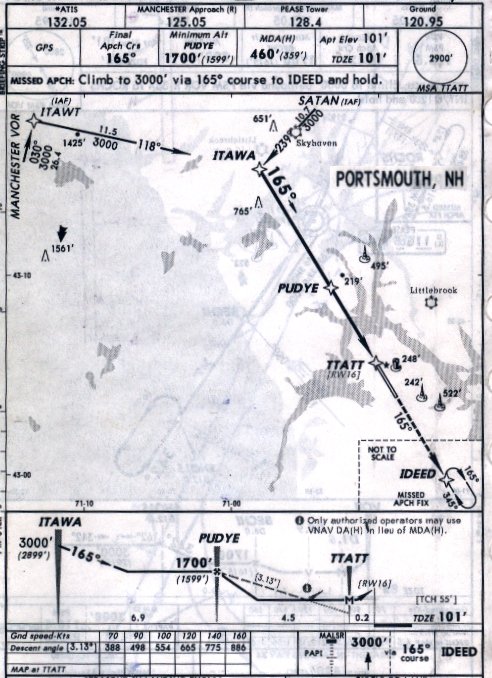bobtilden.com ITAWT... ITAWA... PUDYE... TTATTDecember 6, 2000
Gibberish at first, but if you sound out the words in the title, they become the immortal words of
Sylvester the Cat; I- thought- I -saw- a- puddy- tat. What though, does this have to do with
aviation?
The seemingly blue sky above us is carved into all sorts of different classifications and
designations. There is class A through G airspace, various restricted areas, airways both high and
low, approach paths, intersections, and more. The sky is a spider web of navigation signals, radar
beams, and communication chatter. Sometimes I wonder how the sun ever pokes its way through.
The four strange words of the title are the names of intersections, and every intersection is
identified by a five letter name. It is a big country, with a growing need for these identifiable
points in the sky. Even though the english language is formed from quite an impressive array of
sounds, there is only a finite number of five letter groups that are pronounceable. Those four
particular intersections are waypoints on the landing approach for Portsmouth, New Hampshire.
Some intersections have sensible names. BIZON is near Buffalo. LYSAN is above the town of
Lysander, near Syracuse, and SCIPO is near the town of Scipio. THINK intersection is near the
birthplace of IBM's founder, Thomas Watson. Our governor was honored with PTAKI intersection within the past
few years, but the proposed name TXCUT was never applied to a new intersection near Albany.
Sensible, humorous, or even pronounceable names are becoming scarce though. Some other local
intersections are AGFUB, XUCCO, NUFXO, WOFIL and UMAGY. Fortunately, most of these
outlandish names are connected with the specific procedures used to make instrument landing
approaches; Pilots have a detail map of the approach which clearly shows all the intersections.
Spelling and pronunciation are not critical, since it is unlikely that a pilot could mistake XUCCO
for NUFXO.
A creative hand also comes into play with the formal designations for aircraft call signs. These are
coordinated by an international agency, and no two companies in the whole world can have the
same one. Even the untrained ear can recognize USAIR, AMERICAN, UNITED, or SWISSAIR
when they talk with the controllers, because their name is their call sign. I don't know why
National Airline flights are addressed as REDROCK, but I do know that the ill- fated ValueJet
airline flights were addressed as CRITTER because of the peculiar logo displayed on their tails.
The more colorful names seem to be applied to cargo airlines, sometimes called "freight dogs".
A look through the registry shows several references to boxes, vans, and dawgs, but a freight line
in Hawaii is assigned the standout call sign of UGLY VAN. I will bet Dollars- to donuts that they
operate a fleet of Shorts Skyvans, starkly utilitarian airplanes that look like they are built from
Lego blocks.
In this area a number of night cargo flights operate under the RATTLER call sign, canceled
checks are moved to central banks by a fleet of planes with the STARCHECK call sign, and
medical specimens used to be flown to Smith Kline Beacham's laboratories with planes operating
under the SKIBBLE call sign, a slight corruption of their 3 letter abbreviation SKB. Now that
Quest Diagnostics owns them, the flights operate under the LABQUEST call.
For all its complexity, the air traffic control system becomes a small village as the night wears on.
The same call signs are cleared along the same routes and through the same intersections at the
same time every night. It is much like sitting quietly in the woods for a few hours a day; you learn
the different birds and animals, and then learn the individuals within the different groups.
Like the woodland animals, we find comfort and reassurance in the normal noises around us.
When bad weather lurks, we note the reactions of the others as we each formulate a plan to keep
from harm's way. Despite all of the bureaucracy and technology that underlays commercial
flying, there's room for a surprising amount of what would otherwise be called "animal instinct".
Much can be learned just by watching and listening.

An excerpt of the approach plate for Pease International Tradeport,
(the former Pease AFB) In Portsmouth NH. The upper diagram shows that the approach can
commence from ITAWT or SATAN and then progress through ITAWA and PUDYE. The waypoint TTATT
is the "missed approach point" located a quarter mile from the end of the runway. Unless
otherwise instructed, planes that are unable to land at the end of the approach are expected to
proceed to IDEED (I did see a puddy tat!) and hold.
Pictured below the overhead view is the descent plan, showing the step downs at each waypoint.
Incidentally, the GPS approach to the other end of this runway starts offshore, crosses the beach,
and the missed approach hold is 12 miles farther inland... It is made up of SHOLS, BECHI, and ROCHS intersections..
| Plane Talk Archives |
Return to Home Page |
E- mail Bob Tilden at rdtilden@yahoo.com |
